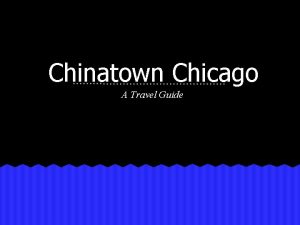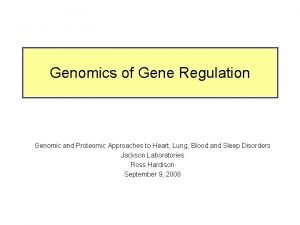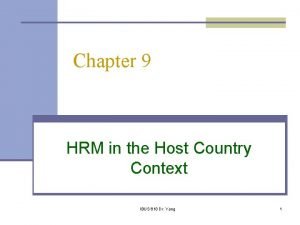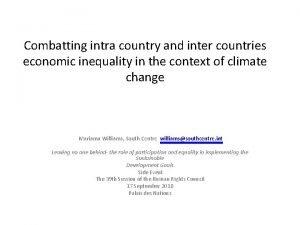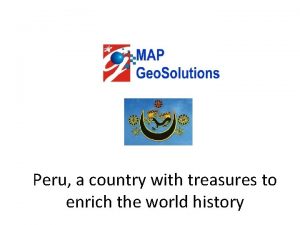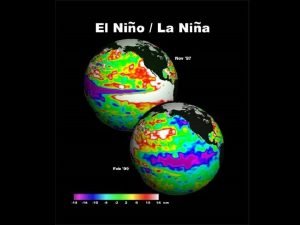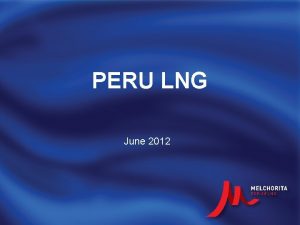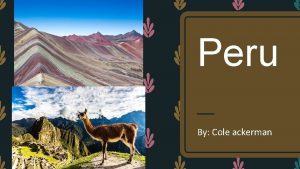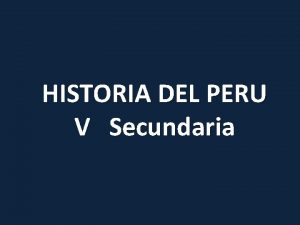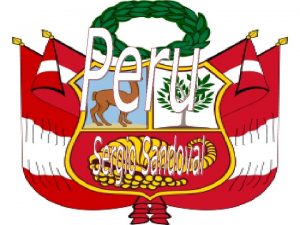Peru a country with treasures to enrich the
















- Slides: 16

Peru, a country with treasures to enrich the world history

Project location The project area is located in the Lambayeque region of northern Peru. It is located 13 kilometers in from of the Pacific coast and 770 kilometers from the nation's capital, Lima.

General information of the project area • Clima: It has a warm and very desert climate with the sun shining all year around. • The main agricultural products of the area are rice, sugar cane and cotton. • Soil type : sandy. • Vegetación: Dry forest and carob tree (Main forest species).

Antecedents of the study area The Moche civilization existed from the years A. D. 100 to A. D. 800, occupying the territory which is now the northern coast of Peru The Brüning Museum in Lambayeque, contains hundreds of gold and silver pieces, as well as textiles and ceramics the Moche Culture. In this museum we can find The Tumba Real (Royal Tombs), which contains artefacts from the tomb of the Lord of Sipan.

Objective of the project Mapping of archaeological sites with Field Map technology to acquire the Certificate of non archaeological rests (C. I. R. A) in order to get the approval for the enlargement of the Picsi prison.

Technology – Field team Software: FMDC Hardware ü Laser impulse 200 ü Electronic compas Map. Star Compass Module II ü Armor computer ü Accessories Engineering Staff : 5 people 1 Archaeologist 2 Field Map operators 2 local guiders ( Reflector)

Archaeological project designed in Field-Map Project Manager § Preparation of satellite images and georeferencing. § Enlargement area Grid of points 75 x 75. Archeological site or Piramide

Archaeological project design in Field Map Project Manager 1. Point: Pits (x, y, z, depth, ) and Topography. 2. Area: archaeological sites 3. a. Ceramics: Type 1, 2, 3 b. Cemetery c. Infrastructure: Walls, murals, hydraulic channel d. Shell Areas: Land cover a. Crops: sugarcane, rice, cereals, etc b. Carob tree forest c. Vegetation: grass, bushes, etc.

Field Activities 1. Mark the limits of the study area positioning stakes every 50 meters: a. Evaluation area b. Enlargement of the prison Area 2. Mark staked grid: 75 M x 75 M. 3. Locate points of the excavation. 4. Mapping the archaeological sites according excavations. 5. Archaeological rescue.

Results 1. Maps of archaeological sites: Cemeteries ceramics, shell middens, infrastructure. 2. Land cover maps: forest and crops 3. Certificate of non archaeological rests for the rescue.

Mapping of the archaeological sites

Next steps • Integrate the codified database of the excavations from the archaeological rescue with its report on platforms and vertical walls. • For future projects in the Amazonas jungle: – Importance of vegetation and topography mapping. – Localization of pits.

Search by plane of archaeological traces with Field Map technology

The project area is located in the Junín region in the central jungle of Peru.

Goals ü Localization and assessment of the deforested areas. ü Archaeological traces ü Guide the pilot by the track planned by using satellite images.

Archaeological traces
 Collector of treasures
Collector of treasures Purity bible verses
Purity bible verses Seven treasures chinatown
Seven treasures chinatown Enrich health and psychology
Enrich health and psychology Prepare/enrich facilitator manual
Prepare/enrich facilitator manual Grammar to enrich and enhance writing
Grammar to enrich and enhance writing Enrich
Enrich Which of the following contains an infinitive
Which of the following contains an infinitive Host country and home country
Host country and home country Intra country vs inter country
Intra country vs inter country Sự nuôi và dạy con của hổ
Sự nuôi và dạy con của hổ Lời thề hippocrates
Lời thề hippocrates đại từ thay thế
đại từ thay thế Quá trình desamine hóa có thể tạo ra
Quá trình desamine hóa có thể tạo ra Vẽ hình chiếu vuông góc của vật thể sau
Vẽ hình chiếu vuông góc của vật thể sau Công thức tính độ biến thiên đông lượng
Công thức tính độ biến thiên đông lượng Thế nào là mạng điện lắp đặt kiểu nổi
Thế nào là mạng điện lắp đặt kiểu nổi


